Thai Roasted Chili Paste, or Nam Prik Pao, is a delicious mix of savory, spicy, and sweet flavors that’s perfect as a condiment, dip, or even a secret ingredient in your favorite dishes. Its smoky, roasted aroma and rich taste make it a must-have for adding a punch of Thai flavor to any meal.
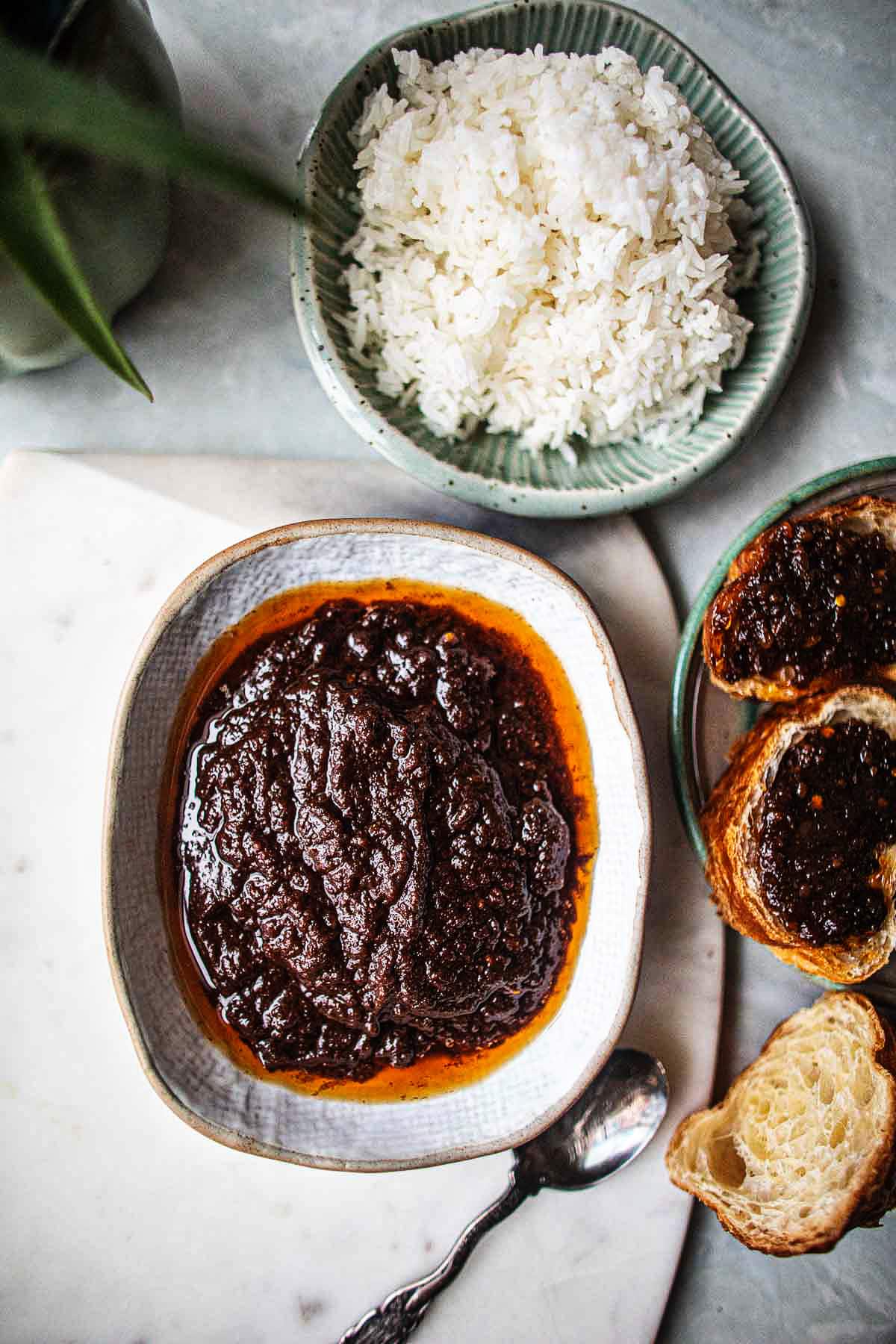
This recipe is created to go along with the other Tom Yum recipes on my site. To cover all the aspects of Tom Yum soups, Nam Prik Pao and authentic homemade Tom Yum paste are crucial for making authentic Tom Yum recipes like this creamy Tom Yum soup with shrimp.
Jump to:
- Why this Recipe Works
- What is Nam Prik Pao?
- Nam Prik Pao Ingredients
- Helpful Kitchen tools
- How to Make Authentic Nam Prik Pao
- Helpful Tips
- Homemade Vs. Store-Bought Nam Prik Pao
- The Best Store-bought Nam Prik Pao Brands
- Different Ways to Use Thai Red Chili Paste
- How to Store Your Sauce
- FAQs
- More Thai recipes you'll love
- Nam Prik Pao (Thai Chili Paste Recipe)
- Other Thai Recipes You'll love
- Pairing
Other Tom Yum recipes are easy chicken Tom Yum, Instant pot Tom Yum Goong, Tom Yum fried rice, Tom Yum soup broth, and authentic homemade Tom Yum paste.
Learn more about tamarind, palm sugar, and dried shrimp here with these helpful blog posts. These key ingredients add unique flavors to several Thai dishes.
Why this Recipe Works
- It's versatile! Use it as a homemade spread like jam on toast.
- Perfect sauce for use at large parties. Add to cooked noodles and garnish with green onions.
- The paste lasts for a while in the refrigerator, up to 1 month!
- Use it on a charcuterie board. Great as a dipping sauce for appetizers.
- Great as a dipping sauce with vegetables, crackers, or bread. Just a little bit goes a long way with this flavorful sauce.
What is Nam Prik Pao?
Nam Prik Pao is a sweet, spicy, and savory Thai chili paste used in many dishes. There are many chili pastes in Thai cuisine, but this one is one of the most common among Thai people.
This spicy sauce is essential to traditional Thai Tom Yum soups. It's authentic flavors and tastes.
It's a good paste to have around all the time as it is versatile and can be used in many dishes. This Thai chili paste is also called Thai chili jam, Thai roasted chili oil, and roasted chili paste in soya oil.
Nam Prik Pao Ingredients

- Dried chilis. Use Thai-dried red chili peppers. Red chili pepper flakes are fine to use, too. You can control your spice level here by using fewer chilis and removing the seeds before using.
- Oil. Neutral oils with high smoking points are best. I usually use canola or vegetable oil for this recipe.
- Garlic. You will need a lot of garlic for this recipe. Use the entire head of garlic.
- Shallot. Cut the shallot into small pieces for this recipe. Purple red onions are not recommended as a substitute.
- Dried shrimp. It's one of the main ingredients that add a rich umami texture to the paste. Please don't skip it. Find these at your local Asian stores.
- Shrimp paste. A potent ingredient that adds a rich and deep salty umami flavor. Please do not skip this one either. The smell is strong, but the flavors are unmatched.
- Sugar. Use white, brown, monk fruit, or palm sugar. Reduce the sugar slightly or use monk fruit if you watch your sugar intake.
- Tamarind paste. Another key ingredient that adds a sour, tangy taste. Also called tamarind juice, sauce, pulp, or concentrate. Don't use rice, white vinegar, or fresh lime juice for this recipe. Read more about tamarind and how to make tamarind paste here.
- Fish sauce. Soy sauce is not a good substitute as it will alter the flavors completely and won't be Thai chili paste anymore. Better to use fish sauce brands from your local grocery store than to substitute with soy sauce or oyster sauce.
- Water. Use warm or cold water. It adds volume and combines all the ingredients in the frying pan during the seasoning process.
Helpful Kitchen tools
- Glass jars
- Wire mesh spatula
- Slotted spoon
- Fine wire mesh strainer, stainless steel
- Small food processor
How to Make Authentic Nam Prik Pao
Making Nam Prik Pao takes a little time, but do not be discouraged. The simple steps and ingredients are straightforward. The key is to have all the ingredients prepped and all the tools set to the side to transfer ingredients.
More detailed instructions are in the recipe card below. See also the helpful kitchen note section below for helpful kitchen tips.

Step 1. Fry the shallot for 3-4 minutes or until the pieces turn golden brown. Transfer with a slotted spoon into the lined plate.
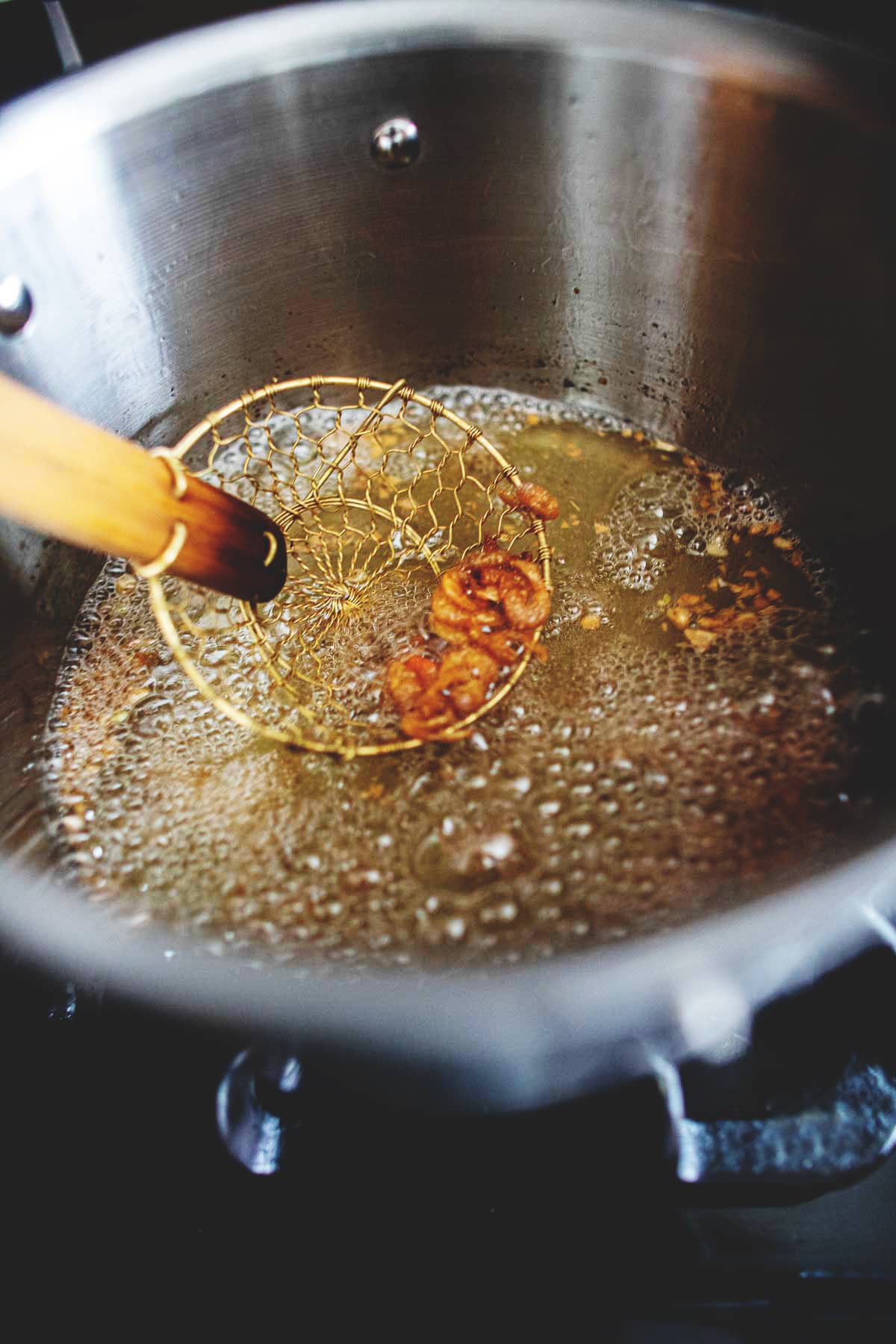
Step 2. Fry the dried shrimp in oil next. These cook very fast, so do not cook longer than 2 minutes. Transfer the shrimp to the plate with fried shallot.

Step 3. Add the sliced garlic to the hot oil. Garlic will cook fast. Fry only for a few seconds, then quickly transfer to the plate.

Step 5. Last, fry shrimp paste until dissolved. The paste will dissolve quickly into the oil.

Step 7. Grind everything in the food processor, plus ⅓ cup oil from the pan, with dissolved shrimp paste.

Step 9. Add water, sugar, fish sauce, and tamarind, whisk some more, and let the paste cook for 8-10 minutes until you get a jammy consistency.

Step 4. Add the red chilies next, and fry for a minute or less. Use a slotted spoon to transfer to the same plate as the garlic and shallot.
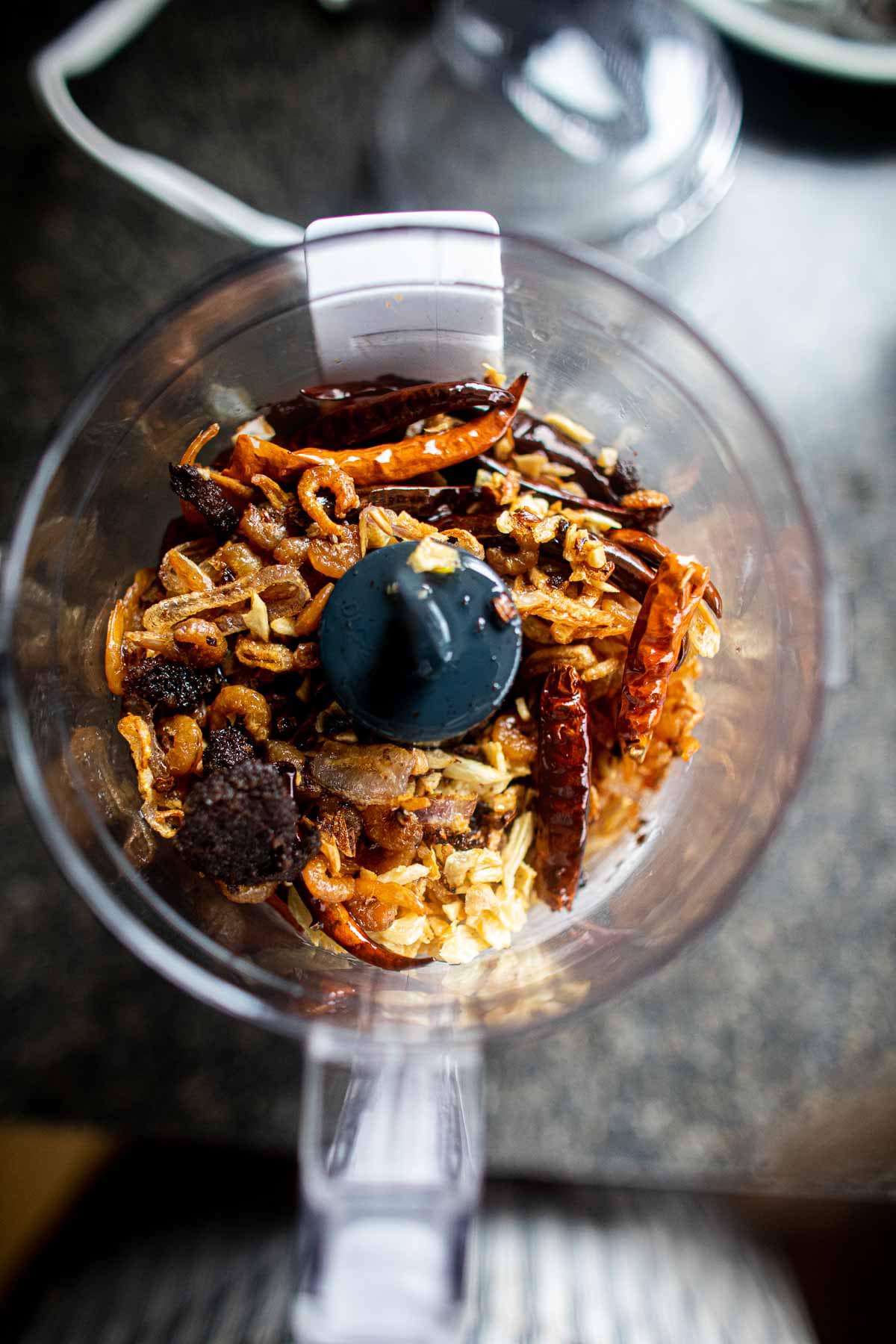
Step 6. Let all the fried ingredients cool, then transfer everything to a small food processor.
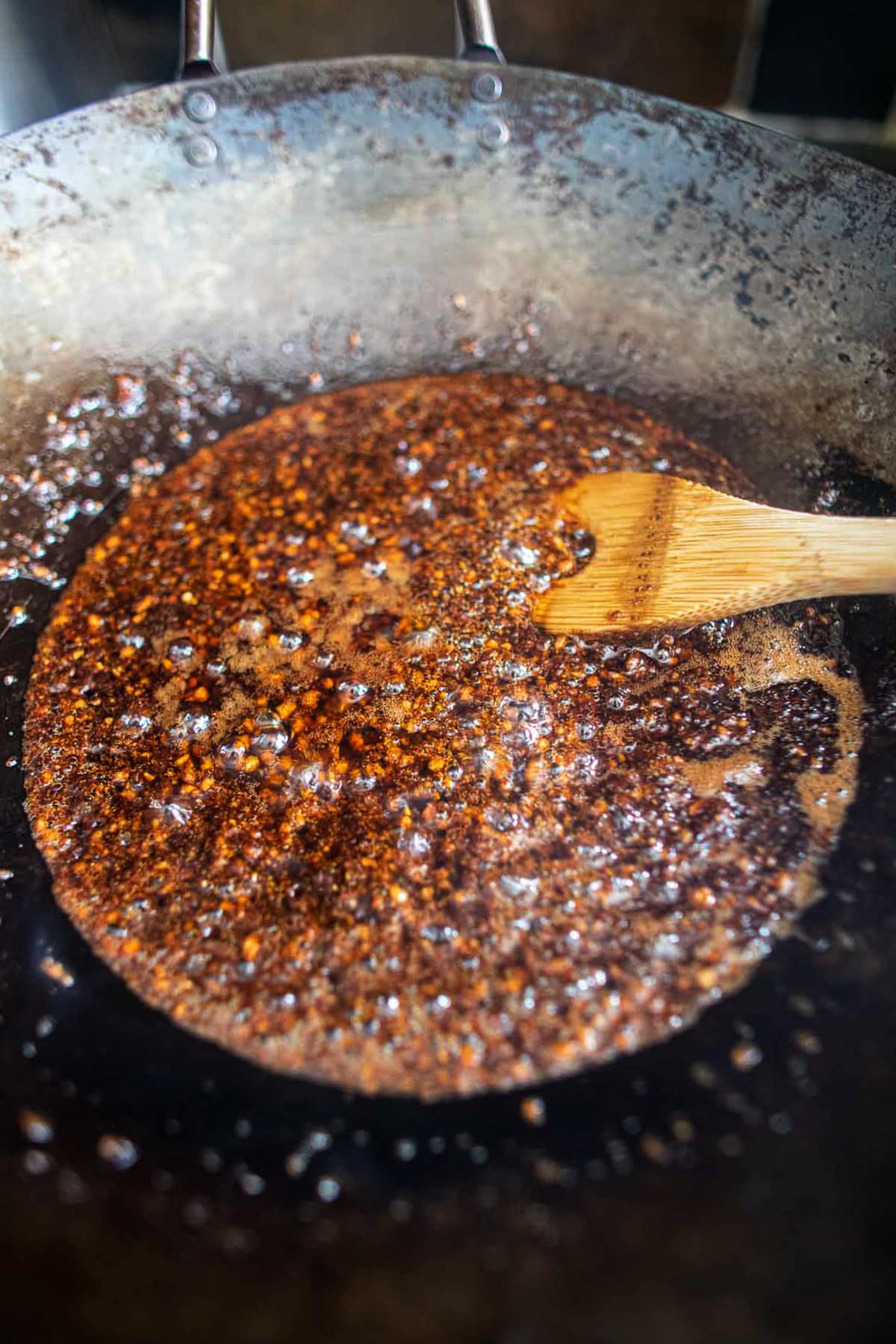
Step 8. Over medium heat, fry the paste from the food processor, and whisk it all together well.

Step 10. Remove from pan into a glass bowl, let cool, and use immediately or store in the fridge for up to 4 weeks and in the freezer for up to 4 months.
Helpful Tips
- Each ingredient needs to be cooked separately as they have different textures and water content. Some will cook longer than others, and if all ingredients are cooked together, you will end up with a mish-mash of overcooked and undercooked ingredients that will not yield the best result.
- The order in which these ingredients are cooked is important. Garlic is small in pieces and cooks much faster. We will be reusing the oil for refrying throughout making Nam Prik Pao. If there's any hint of burnt ingredient in the pan, a bitter taste will linger and spoil the chili paste. Use new oil and continue with the last ingredient you left off.
- Garlic burns very easily, then turns bitter when frying. When your garlic turns brown, quickly remove it from the oil.
- You can skip frying the shrimp paste to reduce the smell and use it in the food processor instead.
- Burn incense, candles, and diffusers and turn the vent and open windows to release some of the smell from the frying oil and seafood. (:
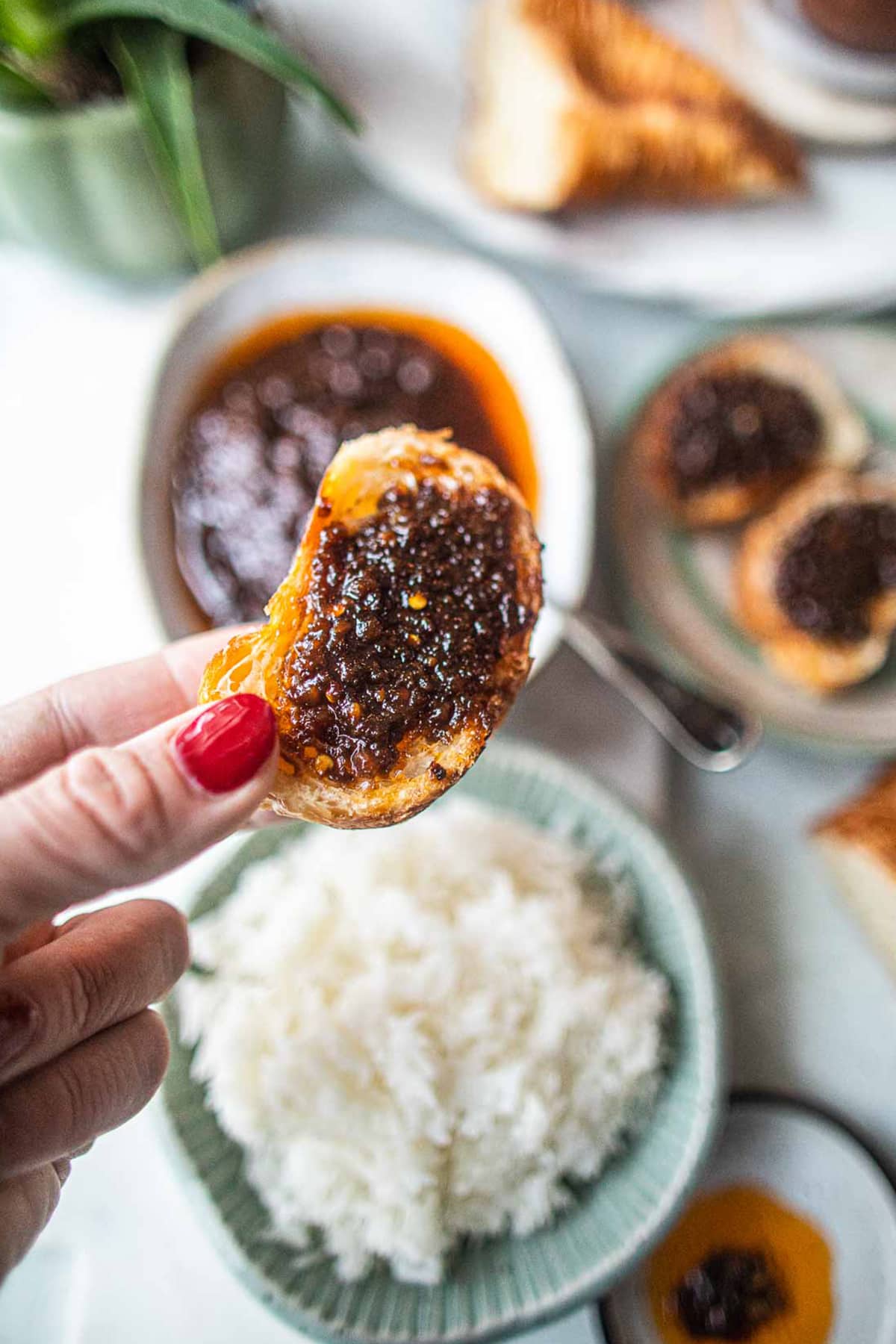
Homemade Vs. Store-Bought Nam Prik Pao
I love making my Thai chili paste to use for different things. But if short on time, I also buy store-bought pastes sold in jars. There are a few brands of Nam Prik Pao out there, and they all have different flavor profiles.
Some are extra sweet, sour, or salty and hard to recommend for use when it comes to Thai chili paste recipes. (That's why I like my own consistent recipe best!)
If a recipe calls for pre-made store-bought Thai chili pastes, adapt the final flavors as necessary with the brand you have.
The Best Store-bought Nam Prik Pao Brands
Here are my suggested pre-made brands to buy. Maesri Nam Prik Pao, Mae Pranom paste, Pan Thai Chili paste in soya bean oil, and Thai kitchen roasted red chili paste.
Different Ways to Use Thai Red Chili Paste
- Add to your favorite fried rice recipe for extra umami flavor.
- Use with bread as spread like on avocado toast.
- Add to a rice bowl with fried eggs and smoked salmon. Super yummy!
- Add to a lettuce wrap for extra flavors.
- Add a scoop or two to your favorite soups to jazz up flavors.
- Use it in any stir-fry dishes for a bit of a Thai kick.
- Add to a bowl of cooked jasmine rice, mix in with chopped green onions or cilantro, and your rice is not so boring!
- Dip balls of sticky rice into the dipping sauce like you would with any dipping sauce and have yourself a fun and easy finger food.
- Use it like a butter spread on a piece of bread, especially homemade bread, toast, or croissant! My favorite bread to use with this oily, savory paste!
- Use it as a thick salad dressing and put some on your favorite salads.
How to Store Your Sauce
Store your Nam Prik Pao in small glass containers for convenience. Smaller portions are easier to serve and allow you to thaw and use just what you need, rather than reheating a large batch repeatedly.
Nam Prik Pao can be used straight from the jar—no reheating needed. Add it to rice, stir-fries, curries, or soups, or enjoy it as a spread on bread, naan, or even lefse! (Yes, I’ve tried it and loved it!)
FAQs
Nam Prik Pao is a popular Thai chili paste in various Thai dishes. The paste is used in Tom yum soups, stir-fries, or a sauce to add to soups, salads, and rice. In Thai cuisine, there is a lot of chili paste.
Nam Prik Pao has a salty, sweet, tangy, and spicy flavor with a deep umami flavor from the dried shrimp, shrimp paste, and fish sauce.
Nam Prik Pao has a flavor profile unique to Thai food, and best not to substitute it. Best to buy a jar from your local Asian grocery stores, or you can make your homemade version with this recipe.
Thai chili paste, Nam Prik Pao, is a unique chili paste with distinct flavors. Best not to substitute it using a recipe with an entirely different flavor profile. They are widely available in regular and Asian grocery stores.
Nam Prik Pao (Thai chili paste) is smoky, sweet, and savory with a thick, chunky texture. It’s great for adding rich flavor to soups, stir-fries, or as a spread. Chili sauce, like Sriracha or sweet chili sauce, is smoother and tangier, with a brighter, simpler heat, perfect for dipping, marinades, or quick toppings. Nam Prik Pao is bold and complex, while chili sauce is easy and versatile.
More Thai recipes you'll love
- Easy Thai tamarind dipping sauce
- Nam Prik Pla
- Thai sweet chili sauce
- Tom Yum Goong, instant pot
- Creamy Tom Yum soup with shrimp
- Red curry with Kabocha squash
- Pad Thai
- homemade sweet chili sauce
- kaffir lime leaves and substitute
** Love a recipe you've tried? Please leave a 5-star rating in the recipe card below and a review in the comments section further down the page. Or follow me on Facebook, Pinterest, or Instagram! **
Print
Nam Prik Pao (Thai Chili Paste Recipe)
- Total Time: 35 minutes
- Yield: 1.5 cups
- Diet: Gluten Free
Description
Thai Roasted Chili Paste Nam Prik Pao is a savory, spicy, sweet paste used as a condiment or a dipping sauce. The deep-roasted smoky flavors from all the ingredients make this sauce incredibly addictive.
Ingredients
- 10 dried long red chilis. Large chili flakes are ok to use. Fine chili powder is not recommended. Remove seeds to reduce heat from the hot peppers.
- 1 cup oil. Canola, vegetable, or avocado oil is best for this recipe.
- 1 whole head of garlic (1.25-1.5 oz) sliced thin and long.
- 1 cup shallot, sliced thin and long
- ⅓ cup dried shrimp
- 2 teaspoons shrimp paste
- ¾ cup sugar, brown, cane, monk fruit, or palm sugar
- 2 tablespoons tamarind concentrate
- 3 ½ tablespoons fish sauce
- ⅓ cup water
Instructions
- Add the oil over medium-high heat in a medium saucepan wok or any pan for deep frying; add the shallot slices once hot. Fry the shallot for 3-4 minutes or until the pieces turn golden brown. Transfer with a slotted spoon into the lined plate. Tips* While the oil is heating up, get a plate lined with paper towels to set on the side for transferring the
- Fry the dried shrimp in oil next. These cook very fast, so do not cook longer than 1 minute. Transfer the shrimp to the plate with fried shallot.
- Add the sliced garlic to the hot oil. Garlic will cook very quickly, especially if they are sliced small. (15-30 seconds)Cook only for a few seconds until lightly golden brown. Then quickly transfer it to the plate.
- Add the red chilies next, and fry for a minute or less. Transfer to the same plate.
- Last, fry shrimp paste until dissolved. The paste will dissolve quickly into the oil. It's ok. It's seasoning the oil for the next step! Remove the pan from heat, transfer it to a heat-proof bowl, and let it cool to room temperature. Turn your vent for this part! Burn a candle or incense afterward to help with the smell. It's worth it, I promise! (:
- Let all the fried ingredients cool, then transfer everything to a small food processor.
- Grind everything in the food processor, plus ⅓ cup oil from the pan with dissolved shrimp paste. Grind until oily paste forms, and stop a few times to scrape the sides of the food processor to get a smooth paste. Grind until you are happy with the texture. I like mine on the semi-side for textures. (:
- Heat the same skillet or wok with the oil from frying the ingredients over medium heat. Once hot, add the paste from the food processor and whisk all together well.
- Time to season the paste next! Add water, sugar, fish sauce, and tamarind, whisk some more and let the paste cook for 8-10 minutes until you get a jammy consistency. Stir frequently to prevent the thick paste from sticking to the pan.
- Remove from pan into a glass bowl, let cool, and use immediately. Or store in a dry clean jar or an airtight container and keep in the fridge for up to 4 weeks and in the freezer for up to 4 months.
Notes
- Each ingredient needs to be cooked separately as they have different textures and water content. Some will cook longer than others, and if all ingredients are cooked together, you will end up with a mish-mash of overcooked and undercooked ingredients that will not yield the best result.
- The order in which these ingredients are cooked is important. Garlic is small in pieces and cooks much faster. We will be reusing the oil for refrying throughout making Nam Prik Pao. If there's any hint of burnt ingredient in the pan, a bitter taste will linger and spoil the chili paste. Use new oil and continue with the last ingredient you left off.
- Garlic burns very easily, then turns bitter when frying. When your garlic turns brown, quickly remove it from the oil.
- You can skip frying the shrimp paste to reduce the smell and use it in the food processor instead.
- Burn incense, candles, and diffusers and turn the vent and open windows to release some of the smell from the frying oil and seafood. (:
** Thank you so much for visiting my blog! This is truly a passion for me. If you have enjoyed these recipes and appreciate the hard work I put into them, I would love it if you would share them with your friends! Your recommendation is the highest review I could hope for, and I’d appreciate it! **
- Prep Time: 15
- Cook Time: 20
- Category: Sauces
- Method: Frying
- Cuisine: Thai
Other Thai Recipes You'll love
Pairing
My favorite drinks pair well with Thai Roasted Chili Paste Nam Prik Pao recipes.



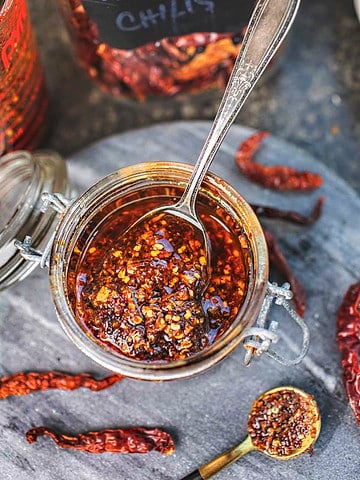
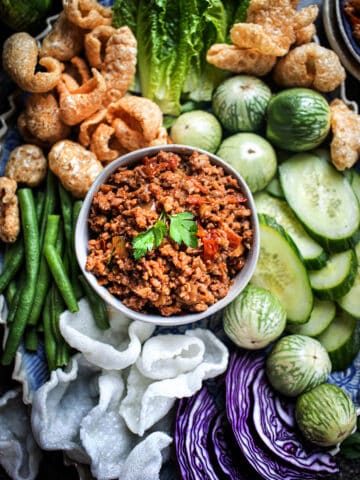
Tammy says
wonderful Paste full of layers of flavors!
Suwanee says
Thank you so much! Such a tasty and versatile sauce, isn't it?
Flipper67 says
I made this. It was really good. I use it on rice & lamb chop. Delicious 😋